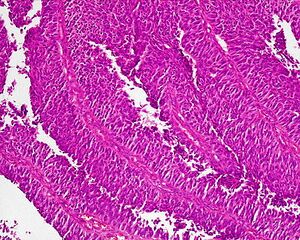Bladder carcinoma
From WikiLectures
They currently make up more than 2% of newly diagnosed malignancies.
Epidemiology[edit | edit source]
- morbidity is still rising, mortality is decreasing, it affects men 3 times more often,
- high incidence - in SW Europe, low in India and Japan,
- the main occurrence is between 50 and 70 years.
Etiology[edit | edit source]
- the main risk factor is smoking (mainly black tobacco smoking),
- exposure to certain industrial pollutants - 'aromatic amines' (benzidine, 2-naphthylamine,…),
- chronic infection, in endemic areas - schistosomiasis (mainly squamous cell carcinoma).
Clinical manifestations[edit | edit source]
- Hematuria and pollakiuria,
- increased bladder irritation indicates an involvement of the neck, when the urethral orifice is affected, hydronephrosis and secondary pyelonephritis may occur,
- sometimes it can be completely asymptomatic,
- general symptoms (anorexia, weight loss, anemia) - are only in very advanced tumors.
Diagnosis[edit | edit source]
- Cystoscopy,
- endoscopic biopsy, eventually transurethral resection → this is necessary to determine the progress
Histopathology[edit | edit source]
- 97% are urothelial carcinomas, rarely adenocarcinomas and undifferentiated carcinomas, squamous cell carcinoma is endemic (schistosomiasis),
- macro - different appearance - papillary, infiltrating, probably in 1/4 they arise multicentricly (this is the cause of frequent recurrences),
- they can start as ca in situ and then change to a papillary or infiltrating form,
- initially the tumor grows in the mucosa, early into the submucosa, muscle and surrounding fat, metastasizes to the pelvic nodes, later paraaortic, more rarely hematogenously.
Treatment[edit | edit source]
The method of therapy depends on a careful evaluation of histology, degree of invasion, extent of the disease.
Surgical treatment[edit | edit source]
- Non-invasive tumors can be treated with transurethral resection (TUR) - it is relatively non-intrusive, it does not affect bladder function,
- for the treatment of surface structures - coagulation or laser vaporization,
- often, however, recurrence occurs within 1 year, so the five-year survival does not exceed 80%,
- therefore it is recommended to supplement adjuvant intravesical CHT, intravesical application of IFN, BCG vaccine, adriamycin, irradiation,
- if the tumor grows into muscle - partial cystectomy is determined,
- the rationality of this procedure is questioned due to the multifocal origin of urothelial tumor
- in addition, there is a risk of implantation metastases, so it is practically not performed today,
- for larger tumors - "radical cystectomy with lymphadenectomy", in men with prostatectomy, in women with hysterectomy, adnexectomy,
- it is a very demanding procedure and its indications must be carefully considered.
Radiotherapy[edit | edit source]
- Most often as external irradiation, it is not used as a separate treatment, for numerous emergency services,
- even as neoadjuvance no significant effect has been confirmed,
- so far radiochemotherapy (RCHT) could have a good effect, but this is not based on studies,
- however, it is irreplaceable as palliation (skeletal meta analgesia, suppression of hemorrhagic complications).
Chemotherapy[edit | edit source]
- Served either locally or systemically,
- local - in diffuse in situ carcinomas, in superficial tumors after TUR and in papillary carcinomas (the most advantageous today seems 'mitomycin C' , which is practically not absorbed from the bladder and does not endanger toxicity),
- systemic - the main palliative treatment advanced forms, the tumor responds to a number of cytostatics,
- most similar to - Pt derivatives, anthracyclines, ifosfamide,
- adjuvant CHT - very useful especially for nodal involvement,
- neoadjuvance - has many disadvantages, it is not done by default.
Photodynamic therapy[edit | edit source]
- This can work in "in situ" carcinomas and in papillary carcinomas.
Immunotherapy[edit | edit source]
- Mainly in the form of local application of BCG.
Prognosis[edit | edit source]
- For non-invasive form, 5-year survival is 75-80%.
Links[edit | edit source]
Related links[edit | edit source]
External links[edit | edit source]
uroonkologie, onemocnění retroperitonea, onemocnění dolních cest močových
Source[edit | edit source]
- BENEŠ, Jiří. Study materials [online]. ©2010. [cit. 16-06-2010]. <http://jirben.wz.cz>.

